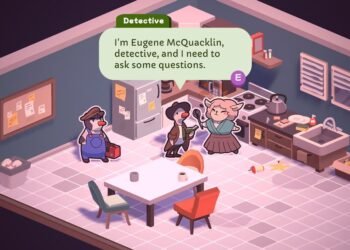Ridley Scott’s 1982 film Blade Runner defined the cyberpunk and tech-noir genres, loosely adapting Philip K. Dick’s novel Do Androids Dream of Electric Sheep? into a visionary depiction of a future Los Angeles where a special unit of the LAPD is tasked with hunting down and killing rogue artificial humans called Replicants.
That setting proved so tantalizing that Free League Publishing’s Kickstarter campaign for a Blade Runner tabletop role-playing game was funded in just three minutes. Set between the events of the original film and Denis Villeneuve’s 2017 sequel, Blade Runner 2049, Blade Runner: The Roleplaying Game launches on Dec. 13. Polygon received an early review copy, plus the chance to spend two hours playing the scenario “Electric Dreams” (which is included in the Blade Runner Starter Set) with Free League CEO and co-founder Tomas Härenstam.

Image: Martin Gripp/Free League Publishing
Willem Novak still carried around his old wedding ring, but now he was only married to the job. This was the hardened Blade Runner’s day off, though, and he was at his favorite noodle shop in Little Tokyo, trying to relax while listening to the toxic rain pouring down outside. He knew his day was about to get a lot worse when the LAPD spinner landed and his new rookie Replicant partner, FN9-2.39 — aka Fenna — stepped out.
“They asked me to bring you in, sir,” she stammered.
“Better make the noodles to go,” Willem said with a sigh.
Blade Runner uses a modified version of the Year Zero Engine found in Free League’s other licensed games, like Alien: The Roleplaying Game and Tales From the Loop. Instead of getting a pool of six-sided dice and shooting to roll as many sixes as possible, players only ever roll two dice, but they can have a d8, d10, or d12 if they’re particularly good at something. Rolling a 10 or above on a single die gives your character two successes.
A table in the core rulebook conveniently shows the chance of success for every possible combo, and how that’s affected if you choose to push your luck and reroll any dice that didn’t initially come up as a 1. You might turn failure into success, but if you roll a 1 while pushing, you take either bodily damage or stress that weakens your resolve, depending on whether you were attempting a physical or mental action. The key difference between Replicants and humans is that Replicants can push twice but always take the damage to their resolve — they’re capable of superhuman feats, but they’re unstable.
Beyond the dice, Blade Runner splices in elements from the investigative board game series Sherlock Holmes: Consulting Detective. You navigate Los Angeles looking for clues in a case that will often involve murder and corporate intrigue. Players must carefully choose how to spend their shifts, since after a certain number have passed, events will trigger that can help or hinder your efforts. If you fail to put all the pieces together in time, the suspect might even flee town, leaving you to face discipline from your boss. Of course, you might also discover along the way that whomever you’ve been chasing doesn’t actually deserve punishment. Sometimes, protecting your own humanity is more important than chasing the next promotion — a conflict that impacts not just your role-playing but character advancement options.

Image: Martin Gripp/Free League Publishing
Captain Holden is a bit of a legend on the Rep-Detect unit, having been shot and nearly killed by a Replicant 18 years ago. He wheezes a bit as he talks, thanks to his artificial lungs. “We have an urgent situation. Last night there was a shooting in a sordid place called the Snake Pit. Two Nexus-9 Blade Runners were there. One was shot dead; the other is missing.”
He sent their files to Willem and Fenna’s data assistants. “There were human supremacists at the Snake Pit last night. Maybe that had something to do with it. You need to figure this out, fast. I have the brass breathing down my neck. If anyone is killing or kidnapping Nexus-9s, we need to find out. You can play this any way you want, so long as you get results.”
The Blade Runner Starter Set contains a condensed version of the rules, four pregenerated characters, and the aforementioned “Electric Dreams,” a rich adventure we only scratched the surface of in our two-hour session. It also includes a Rep-Detect case file filled with glossy, high-quality handouts such as surveillance footage, profiles from the LAPD database, and newspaper clippings. The materials are also available digitally through Foundry Virtual Tabletop.
In one instance, we were able to look over a photo taken outside Snake Pit the night of the incident, trying to puzzle out hidden details. The provided props can make it feel intimidating for game masters hoping to create their own adventure as it sets a high bar, but there are plenty of prompts to inspire interesting cases with clever twists in the core book. Luckily, Free League plans to produce plenty more high-end case files.

Image: Free League Publishing
Neither of our characters was able to make a successful tech check to zoom in on the image, which would have provided us access to a more detailed view. The case is designed with so many possible avenues of investigation that if you miss a few clues, your progress won’t be blocked. We just had to set out to the Snake Pit to see the scene ourselves, using our investigative and social skills to gather physical evidence and try to cajole information out of witnesses.

Image: Martin Gripp/Free League Publishing
Fenna and Willem had been talking to Iris, a Replicant dancer who was performing the night of the incident. She’d seen the missing Blade Runner Leah talking to a regular named Styles who had gotten involved in a brawl with the human supremacists. Fenna had clocked him outside, watching the crime scene with keen interest. The partners decided it was time they had a chat, but before they could get too close, Styles took off running.
The thrill of the chase is key to Blade Runner. There are tables in the core rulebooks for chase scenes that take place on foot, in ground vehicles, or in the air, and the starter set includes cards that can be used to make the system feel even more like a proper minigame. Each round, the pursuer and the pursued secretly choose an action — such as continuing to try to close the distance, hiding, or standing and shooting — and then make skill checks to determine the results.
There’s also a deck of complications based on the setting of the chase that can modify the difficulty of the actions. Hiding becomes easier if you wind up in a sea of people with umbrellas, for instance, while a barricaded road might stop you from moving unless you can force your way through. Depending on how things play out, the suspect could escape, lead you into a trap, or end up in handcuffs.
Combat is sometimes necessary, but it’s appropriately brutal. All melee actions are opposed rolls, which means missing is impossible. Someone is getting hurt, and it’s just a matter of who. Fail by too much and you’ll wind up with a critical injury, which can debilitate you until your character gets some medical treatment. Being crit can even permanently maim or kill your character outright. While Dungeons & Dragons makes fighting the de facto way to handle most conflicts, Blade Runner wants you to think really hard about resorting to violence.
We didn’t get to experience one of the game’s other pillars, downtime, which allows your character to rest and recuperate. Downtime can also potentially introduce complications based on the case or your character’s backstory. Willem might have gotten a threatening visit from his crooked former partner or a call from an NPC with information about Leah they could share in return for a favor. Depending on how we performed in the investigation and the tough decisions we made along the way, we could earn promotion points that unlock new gear and pay raises, or humanity points that can be spent leveling up skills.
Blade Runner nails the vibe of its source material. While it can play up to four people, it provides an experience that feels uniquely well suited to two — partners working the case together, sometimes forced to split up to cover more ground, even if it can put them in a very dangerous situation. Los Angeles 2039 is full of secrets, and I’m eager to team up with a friend and uncover more of them.
Blade Runner: The Roleplaying Game goes on sale Dec. 13 at bladerunner-rpg.com. The core rulebook costs $50, the starter set is $47, and both can be bought together along with a digital version as part of a $115 bundle.
Blade Runner: The Roleplaying Game was reviewed with pre-release copies of the book and starter set provided by Free League Publishing. Vox Media has affiliate partnerships. These do not influence editorial content, though Vox Media may earn commissions for products purchased via affiliate links. You can find additional information about Polygon’s ethics policy here.















































